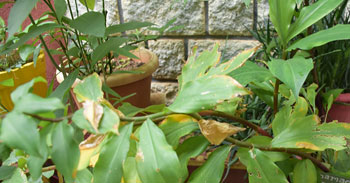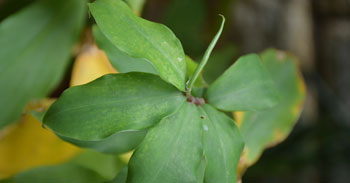KJC Medicinal Garden
Kempu honne
Chamaecostus cuspidatus
Order: Zingiberales
Family: Costaceae
Genus: Chamaecostus
Species: C . cuspidatus
Common Names: Spiral flag , Fiery costus , Insulin plant .
Native to Eastern Brazil (States of Bahia and Espirito Santo)
Other plants of the same genus with medicinal properties
-
C . curcumoides
C . fragilis
C . fusiformis
C . subsessilis
- Perennial , upright , plant grows upto 2 feet tall.
- Leaves: simple , alternate , entire , oblong , parallel venation , spirally arranged around the stems , large , fleshy , smooth and dark-green leaves have a light purple underside.
- Tallest stems fall and lie on the ground .
- Flowers: orange , cone-like head on tips of branches and 1.5 inches in diameter.
- Fruits – green coloured and less than 0.5 inch .
Uses in Tradition systems of medicine
- Chamaecostus cuspidatus is a traditionally used medicinal plant and a common member of ornamental plants in south Indian Gardens. Leaves are the important part which produces significant antidiabetic activity. It reduces fasting as well as postprandial blood glucose levels.
- Leaves are used as anti- diabetic.
- The stem is majorly reported with antiurolithiatic activity. Both stem and root have been shown significant antioxidant activity.
- The rhizome of the insulin plant is useful in burning sensation, constipation, leprosy, worm infection, skin diseases, fever, asthma, bronchitis, inflammations, and anemia .
- Protein – 15.3 % , phosphorus – 6.6 mg , calcium – 5.1 mg
- Iron – 120 mg , ascorbic acid – 216 mg
- Beta-carotene – 1833 µg , alpha-tocopherol – 25 mg , phenols – 2.1 g , flavonoids – 1.89 mg/g , glutathione – 75 mmol .
Suggested Medicinal Properties
- Antimicrobial
- Antidiabetic
- Antiproliferative
- Antioxidant
- Anti-inflammatory
- Hepatoprotective properties
- Anti- hyperglycaemic
- Antiurolithiatic
Active Phytochemicals
1. Phytochemicals of Costus leaves are rich in protein, iron, and antioxidant components such as ascorbic acid, α-tocopherol, β-carotene, terpenoids, steroids, and flavonoids.
2. The methanol extract was found to contain the highest number of phytochemicals.
3. Wild plant and callus extracted with different solvents in preliminary screening indicated the presence of high content of phytochemicals like phenols, alkaloids, flavonoids, and terpenoids in methanolic extracts .
References
Nutrient profile and antioxidant components of Costus igneus by D , Vishalakshi Devi , A. Urooj (2010) , Indian Journal of Natural products and Resources 1(1):116-118.
Review on medicinal exploration of Costus igneus : The Insulin plant by Flowerlet Mathew , Bimi Varghese (2019) , International Journal of Pharmaceutical Sciences Review and Research 54(2) , Article No. 10 , Pages : 51 – 57 .
www.theplantlist.org

